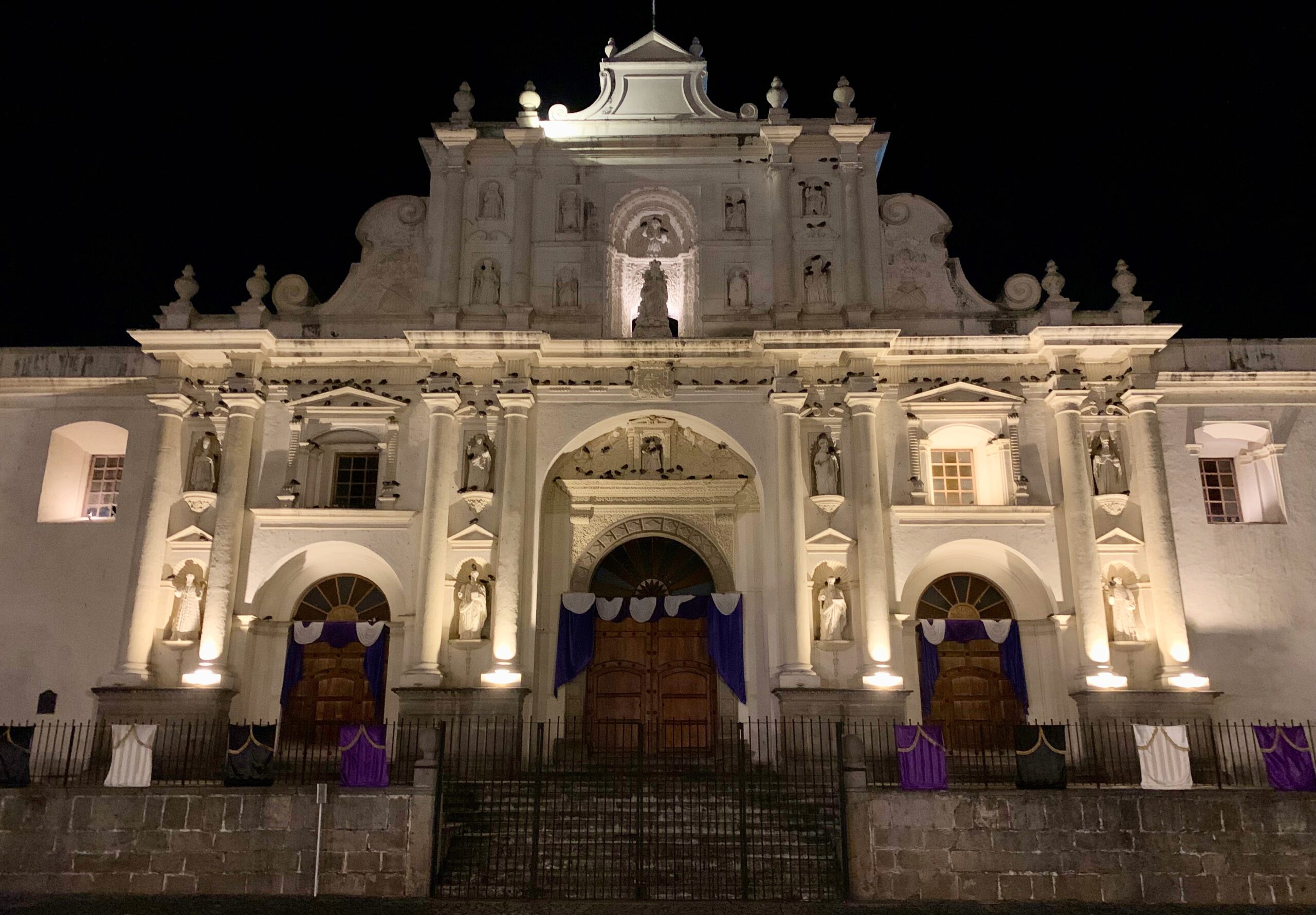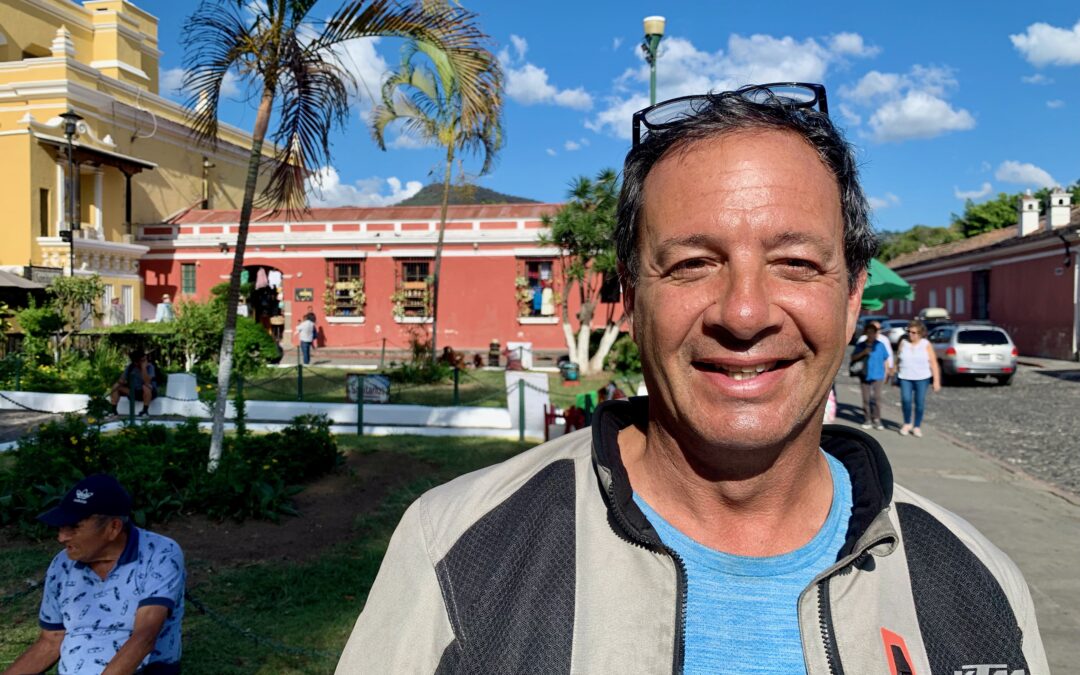Match 24th 2023, Antigua, Guatemala.
For the first time on this long journey, I have travelled with a biking buddy. I went from El Tunco in El Salvador to Antigua, Guatemala, a distance of some 260 kilometers and very largely an uneventful journey . . . until I fell over on some uneven ground at the side of the road just outside Antigua. Nothing damaged save for my ego.
Since setting out last November from Puerto Williams, the small Chilean town on Isla Navarino beside Cape Horn, I have covered around 14,000 kms, almost every inch of it on my own, which is rather odd when I think of it. At the outset, I wanted to do this journey alone so that my concentration would be on where I was at any time — and by that I mean the scenery, landscape and buildings — and the people I would meet along the way. I am not a loner by nature, though I am comfortable in my own company, but there have been times over those 14,000 kms when I have thought “What the feck are you at? You’re in the middle of nowhere; this is getting boring and there’s a long way to go”! The feeling doesn’t last long because, of course, it’s not boring. Not at all. How could it be?
There have been times when I have felt lonely. Like when there’s something important going on with the family back home or I know that my presence might help in some way. I have missed three birthdays, one a big one for Moira, my wife, and I’ve a similar one looming. I’d rather have watched last weekend’s rugby match at home rather than listen to it on my phone in a hostel in Managua, trying to explain to mystified young Germans and French Canadians why the result was vastly more important than anything was ever likely to be in their lives. I think I failed.
Having left Managua, passed through Honduras and spent a couple of nights in San Salvador, I rode on down to El Salvador’s Pacific coast. I went there because I heard it was a magnet for surfers and I thought I’d like to see a bit of that — what was the attraction for them, what did the place look like? Actually, it is rather what you’d expect — lots of surf schools and low rise boutique hotels in dense tropical settings; lots of young men with surf boards, and a lot of great looking young women, mostly but not always without surf boards. The resort strips that line the coast have the usual trinket and clothes shops and bars-cum-restaurants, lots and lots of them. The seaside setting is great: palm trees and mangroves, and liberal use of bamboo poles and palm leaves to blur the distinction between the natural world and ours. There was no surfing however; the waves weren’t right, apparently, and the Pacific still looks rather grey and uninviting, at least to me, when compared to the Caribbean.
The road hugs the coast and at El Tunco, I swung off to find a hostel, stopping more or less at the first one. The woman there said a room was $55 for a night, which I thought was a bit steep and declined. Ok, she said, how about $40, which I accepted. There was a small pool and I was sweaty and tired. After a bit of exploring (actually foraging to acquire beer) I returned to find another bike had appeared — a KTM with an Argentine plate. The rider introduced himself — Fernando de Rosas from Mendoza — and we got chatting.
He’s 55 and has a number of businesses, including one making pallets for vineyards. Mendoza is the center of Argentina’s very significant wine industry. I told him I had been there some years ago and visited the Uco Valley and Doña Paula. He asked where I was going and said he was going to Alaska too but tomorrow, he would be heading for Antigua. Me as well, I said, why don’t we ride together and so we did.
We set off just before 8am and the road west, hugged the coast for perhaps 20 kms. It is quite a jagged coast because of numerous small valleys that flow off mountains running parallel with it and then dip into the sea, creating a string of inlets. And so the road fell with the valley sides and rose again out of them, delivering wonderful panoramas around almost every corner. I was riding in front and felt awkward about stopping to take photos and so I didn’t. You know the way it is with a new friend whom you don’t really know. Is he going to be really pee-ed off if I stop to take pix? I didn’t even know if I was going at a speed that suited him. When I did pull over, Fernando was first to speak, saying you know, if you want to stop for photos, just go ahead, its fine with me! Of course, the best scenery was behind us by then!
The road soon went inland, making its way to the frontier with Guatemala. It’s sugarcane harvest time at present and there were lots of huge trucks on the road, pulling two and three open top container-sized trailers laden with sugarcane stalks. The harvesting is done by machine now but I still associate the crop with slavery and the brutal way in which the canes used to be hand cut by men wielding machetes.
At the frontier, the El Salvadoran passport man indicated to me to lean down to the tiny opening in the glass screen hatch behind which he sat. A colleague was beside him.
“My friend has a question for you,” the official said in perfect English. “He wants to know which is the best Irish whiskey?”
“Well,” I answered, “It will either be Bushmills or Jameson.”
“Yes!” he responded almost triumphantly, “Jameson — is the best, no?”
“Well I like it,” I said, and he waved me through with a smile.
We got to Antigua just in time for me to write this and take a short walk to the main square, the Plaza Mayor, and see the cathedral, lit up at night.

I’ve been here before — the whole family has — visiting our daughter Natasha, who worked as a volcano guide, leading tours up the 3,976m high Acatenango. It is an old Spanish colonial town, founded in the 16th century and was the capital of Guatemala until a series of earthquakes wrecked it in the late 18th century. The streets are mostly cobbles and few of the buildings are more than two storeys. It is littered with the ruins of huge churches and other grand relics of Spanish rule but, more than anything else, it is a tourist town now.
I had some beer with Fernando, talking biking and Argentina — “what’s the problem?” I asked him. “Populist politics,” he answered, the umpteenth Argentinian to come up with that diagnosis. But he still loves his country and the life it has given him. Next morning, we went to the bakery and restaurant Doña Luisa Xicotencati where they serve the best breakfast in all Antigua. (Some years back, I wrote about her in The Irish Times here: https://www.irishtimes.com/news/world/colonial-legacy-remains-strong-in-guatemala-s-streets-1.2565141). The following day, Fernando headed off to Mexico, to the Baja California peninsula for some off road biking, while in due course, I will head towards Chiapas and Tabasco and, eventually, Mexico’s border with the USA.
I’m sorry I didn’t meet Fernando earlier; he’s been a very pleasant biking companion. Go safely my friend.
This piece appeared first in The Irish Times online on March 27th 2023.

It’s always good to hook with a like minded biker bud. I hooked up with an Ozzie and an Argentinian on Transalps in Buenas Aires after a week on the tear over St Patricks Day. After a weekend’s hospitality by other Transalpers in Rosario (an XT 600 club was not a thing back then apparently), before blasting to Cordoba and up the Bolivian Border at La Quiaca. Our Argentinian bud left, and Jim and me and we were forced on to the train to Uyuni (No Hay Puente! A common refrain due to La Nina) – after a fun crossing of the Salar we arrived in Santa Cruz for easter – not desirable as there was no beer to be had, but we were resourceful it must be said. Jim sold his bike and flew to the UK – I continued solo up to Caracas, mostly by river boat via Puerto Vehlo and Manaus. Ah those were the days.